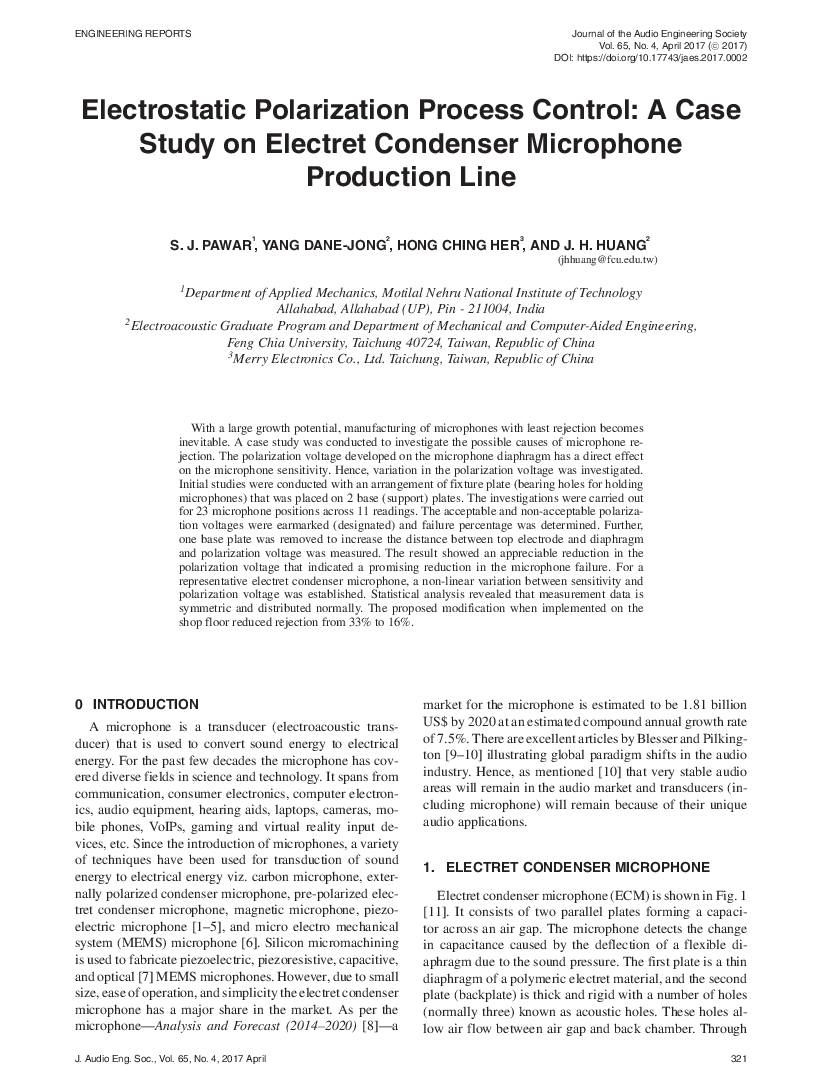Home / Publications / E-library page
You are currently logged in as an
Institutional Subscriber.
If you would like to logout,
please click on the button below.
Home / Publications / E-library page
Only AES members and Institutional Journal Subscribers can download
With the expanding market for low-cost microphones, raising the manufacturing yields (lowering the rejection) becomes a central technical issue. This report explores a case study of possible causes of electret microphone rejection. Because the polarization voltage developed on the microphone diaphragm has a direct effect on the microphone sensitivity, hence variations in this voltage were investigated. Initial studies were conducted with an arrangement of fixture plate (bearing holes for holding microphones) which was placed on two base (support) plates. The investigations considered 23 microphone positions across 11 readings. The acceptable and unacceptable polarization voltages were designated, and the corresponding failure percentage was determined. Furthermore, one base plate was removed to increase the distance between top electrode and diaphragm, and polarization voltage was measured. The results showed an appreciable reduction in the polarization voltage that indicated a promising reduction in the microphone failure rate. For a representative electret condenser microphone, a nonlinear variation between sensitivity and polarization voltage was established. Statistical analysis revealed that measurement data is symmetric and distributed normally. The proposed modification, when implemented on the shop floor, reduced rejection from 33% to 16%.
Author (s): Pawar, S. J.; Jong, Yang-Dane; Her, Hong Ching; Huang, Jin H.
Affiliation:
Department of Applied Mechanics, Motilal Nehru National Institute of Technology Allahabad, Allahabad, India; Electroacoustic Graduate Program and Department of Mechanical and Computer-Aided Engineering, Feng Chia University, Taichung, Taiwan, Republic of China; Merry Electronics Co., Ltd. Taichung, Taiwan, Republic of China
(See document for exact affiliation information.)
Publication Date:
2017-04-06
Import into BibTeX
Permalink: https://aes2.org/publications/elibrary-page/?id=18564
(510KB)
Click to purchase paper as a non-member or login as an AES member. If your company or school subscribes to the E-Library then switch to the institutional version. If you are not an AES member Join the AES. If you need to check your member status, login to the Member Portal.

Pawar, S. J.; Jong, Yang-Dane; Her, Hong Ching; Huang, Jin H.; 2017; Electrostatic Polarization Process Control: A Case Study on Electret Condenser Microphone Production Line [PDF]; Department of Applied Mechanics, Motilal Nehru National Institute of Technology Allahabad, Allahabad, India; Electroacoustic Graduate Program and Department of Mechanical and Computer-Aided Engineering, Feng Chia University, Taichung, Taiwan, Republic of China; Merry Electronics Co., Ltd. Taichung, Taiwan, Republic of China; Paper ; Available from: https://aes2.org/publications/elibrary-page/?id=18564
Pawar, S. J.; Jong, Yang-Dane; Her, Hong Ching; Huang, Jin H.; Electrostatic Polarization Process Control: A Case Study on Electret Condenser Microphone Production Line [PDF]; Department of Applied Mechanics, Motilal Nehru National Institute of Technology Allahabad, Allahabad, India; Electroacoustic Graduate Program and Department of Mechanical and Computer-Aided Engineering, Feng Chia University, Taichung, Taiwan, Republic of China; Merry Electronics Co., Ltd. Taichung, Taiwan, Republic of China; Paper ; 2017 Available: https://aes2.org/publications/elibrary-page/?id=18564
@article{pawar2017electrostatic,
author={pawar s. j. and jong yang-dane and her hong ching and huang jin h.},
journal={journal of the audio engineering society},
title={electrostatic polarization process control: a case study on electret condenser microphone production line},
year={2017},
volume={65},
issue={4},
pages={321-332},
month={april},}
TY – paper
TI – Electrostatic Polarization Process Control: A Case Study on Electret Condenser Microphone Production Line
SP – 321 EP – 332
AU – Pawar, S. J.
AU – Jong, Yang-Dane
AU – Her, Hong Ching
AU – Huang, Jin H.
PY – 2017
JO – Journal of the Audio Engineering Society
VO – 65
IS – 4
Y1 – April 2017